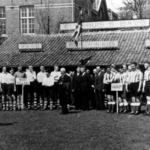Een wankel vertoog. Over ontzuiling als karikatuur
DOI:
https://doi.org/10.18352/bmgn-lchr.7380Keywords:
PillarizationsAbstract
A Shaky Exposition: On De-pillarisation as a Caricature
Dutch twentieth-century history is regularly constructed on the basis of the antithesis of verzuiling (pillarisation) and ontzuiling (de-pillarisation). The popular discourse of de-pillarisation suggests the dismissal, around the 1960s, of three societal characteristics: segregated religious and ideological communities (pillars); the societal dominance of such communities; and pacifying cooperation among social elites. De-pillarisation thus connects to the discourses of individualisation, secularisation and politicisation. Conversely, this article proposes seeing a shift in the way citizens have organised themselves – a shift from heavy to light communities – as the essential transformation in Dutch post-war history. From this perspective, the discourse of discontinuity is replaced by a panorama of gradual change. Individuals became more independent and organised themselves more loosely; religious traditions were only admitted to public life as long as they proved to be bonding elements; and politicians legitimized their policies by means of a dialogue among experts whilst, by and large, maintaining their pacifying style.
Downloads

Downloads
Published
Issue
Section
License
Authors who publish with this journal agree to the following terms:
a) Authors retain copyright and grant the journal right of first publication with the work simultaneously licensed under a Creative Commons Attribution 4.0 International (CC BY 4.0) that allows others to share the work with an acknowledgement of the work's authorship and initial publication in this journal.
b) Authors are able to enter into separate, additional contractual arrangements for the non-exclusive distribution of the journal's published version of the work (e.g., post it to an institutional repository or publish it in a book), with an acknowledgement of its initial publication in this journal.
c) Authors are permitted to post their work online (e.g., in institutional repositories or on their website) prior to and during the submission process.
Authors are explicitly encouraged to deposit their published article in their institutional repository.











